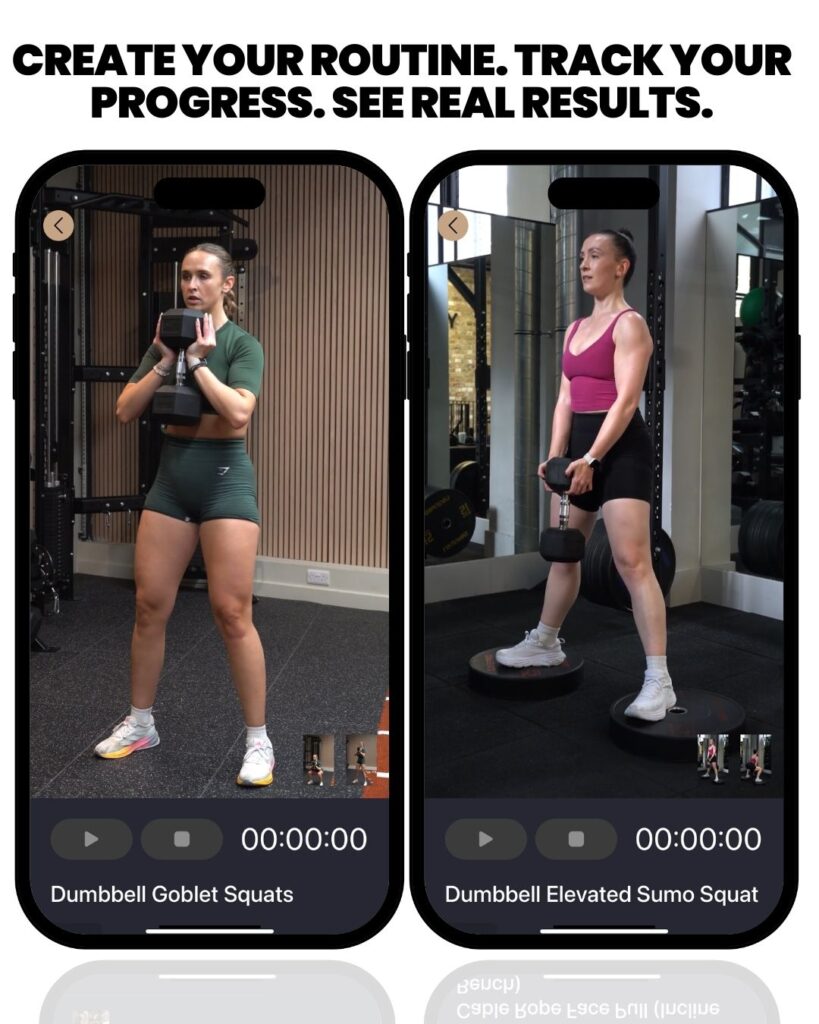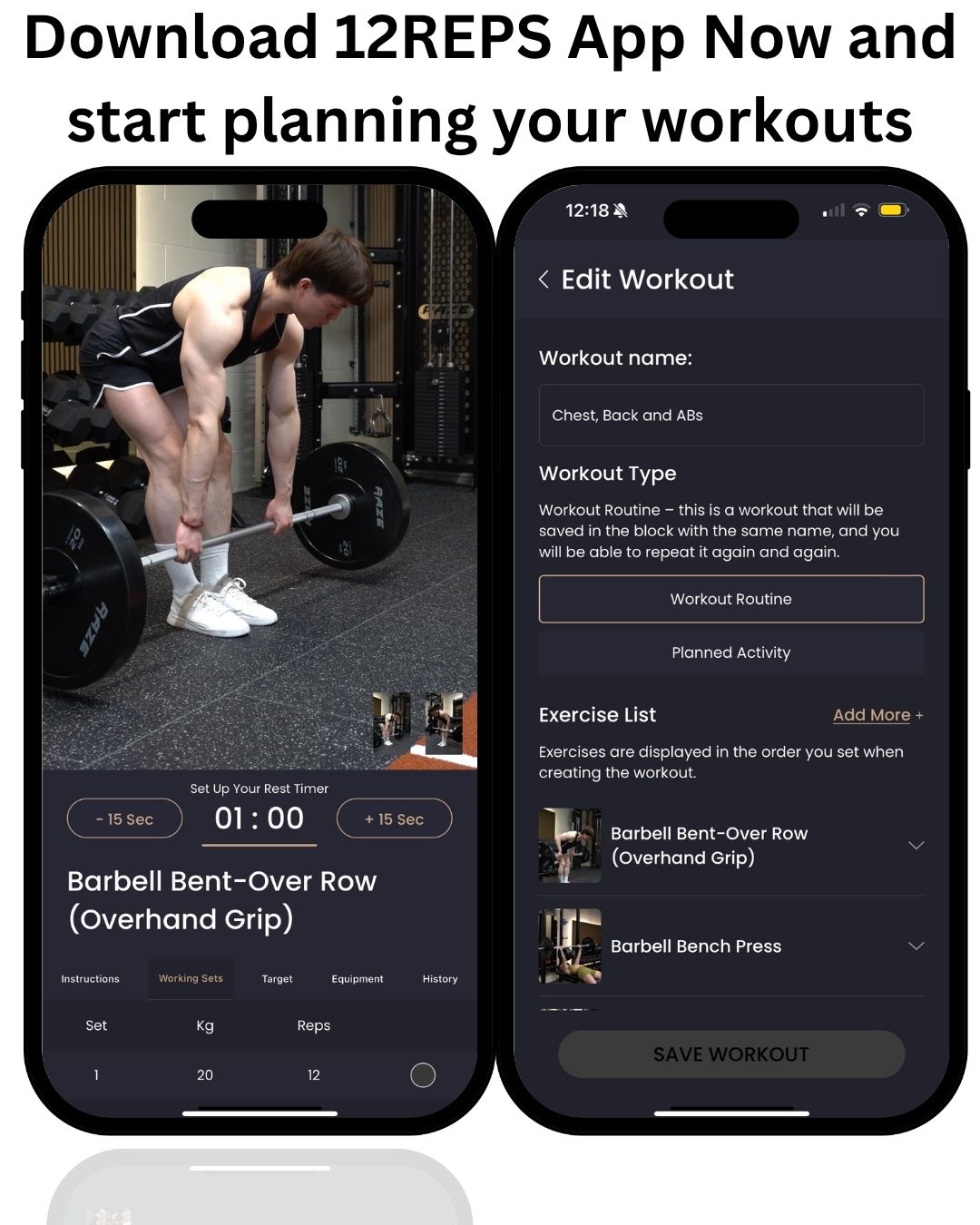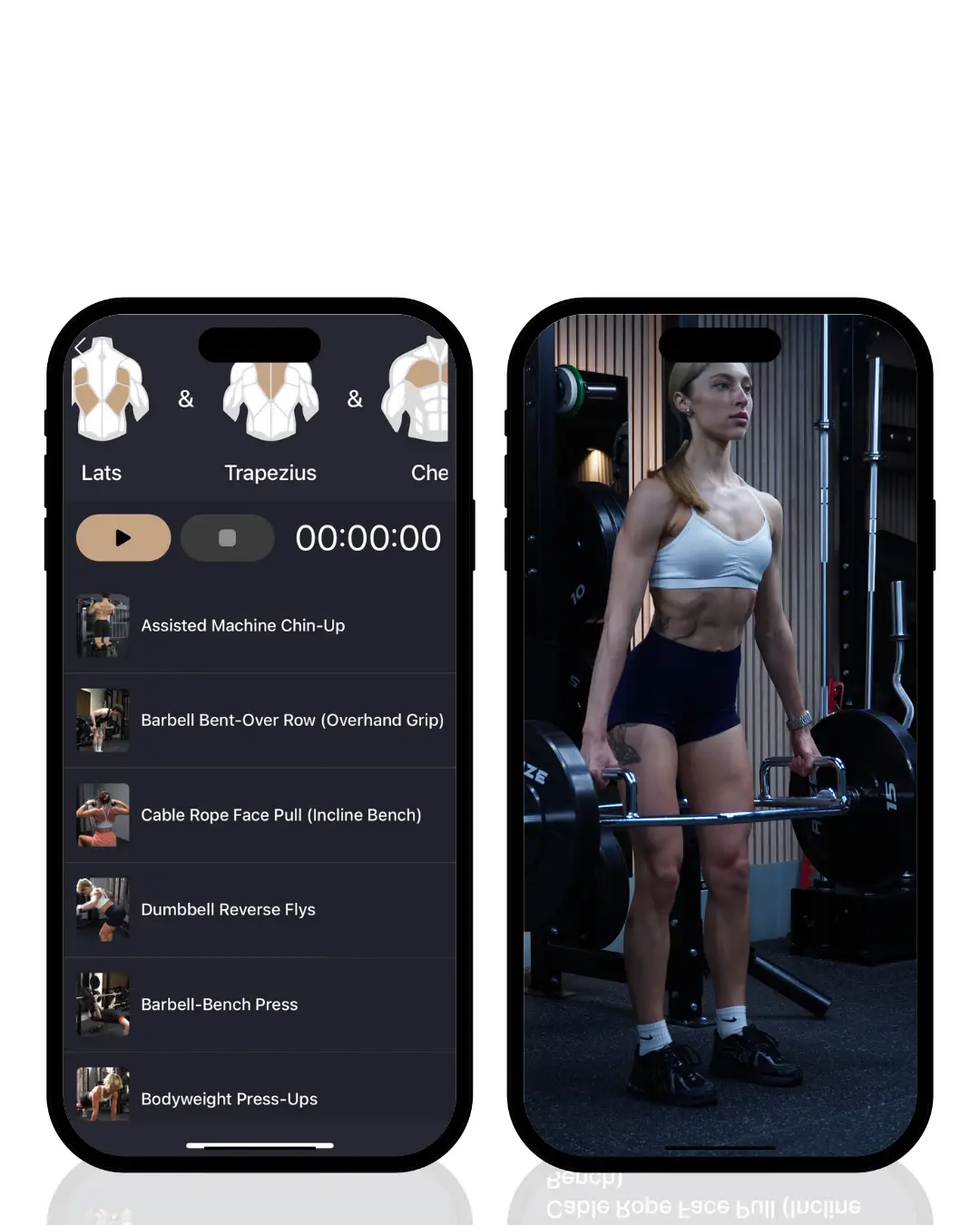By Will Duru, BSc (Hons) Sport and Exercise Science, Award-winning Personal Trainer with over 10 years of experience in strength training and optimising recovery
In the vast and often complex world of strength training, methodologies abound, each with its own set of principles and promises. From high-intensity, low-repetition Powerlifting to high-volume, endurance-focused circuits, it can be challenging to determine the most effective approach for your specific goals.
However, one particular method has stood the test of time and scientific scrutiny, consistently proving to be the cornerstone of effective muscle growth: the 12-rep workout. This article will delve into the science behind the 12 rep range benefits, explaining why this specific repetition scheme is so effective for hypertrophy (muscle growth), and how you can leverage this powerful method to build a stronger, more resilient physique, all while using a structured platform, like the 12reps app, to guide your journey.

The Science of Muscle Growth (Hypertrophy)
To understand why the 12-rep workout is so effective, it’s essential first to grasp the fundamental principles of how muscles grow. Muscle hypertrophy is a complex hysiological process that occurs in response to stress placed upon the muscle fibers. When you engage in resistance training, you create microscopic tears in your muscle tissue. In response, your body initiates a repair process that not only fixes these micro- tears but also adapts by building the muscle fibers back thicker and stronger to handle similar stress in the future better. This adaptation is what we recognize as muscle growth.
There are three primary mechanisms that drive muscle hypertroph
Mechanical Tension: This refers to the force placed on the muscle during a lift. It is arguably the most critical factor for muscle growth. Mechanical tension is generated by lifting a challenging weight through a full range of motion. The more tension you can create, the greater the stimulus for growth
Metabolic Stress: This is the “burn” you feel during a challenging set. It’s the result of the accumulation of metabolic byproducts, such as lactate and hydrogen ions, within the muscle cells. This metabolic stress signals the body to release anabolic (muscle-building) hormones and can contribute to cell swelling, a factor that also contributes to hypertrophy
Muscle Damage: As mentioned earlier, resistance training causes microscopic damage to muscle fibres. This damage triggers an inflammatory response and a cascade of cellular processes that lead to muscle repair and growth. An effective strength training program will ideally create a balance of these three mechanisms to maximise the hypertrophic response. This is precisely where the 12-rep range benefits shine.

Why the 12-Rep Range is a Sweet Spot for Hypertrophy
The 12 reps workout is a classic example of training within the moderate repetition range, typically defined as 8-12 repetitions per set. This range has long been favored by bodybuilders and fitness enthusiasts for its ability to stimulate muscle growth effectively. Here’s a scientific breakdown of why this is the case:
1, Optimal Balance of Mechanical Tension and Metabolic Stress The 12-rep range strikes an ideal balance between the two primary drivers of hypertrophy: mechanical tension and metabolic stress. To complete a set of 12 repetitions, you need to select a weight that is challenging but not so heavy that you can only lift it for a few reps.
This ensures that your muscles are under significant mechanical tension for a sufficient duration. At the same time, the extended time under tension (typically 30-60 seconds for a 12-rep set) leads to a significant accumulation of metabolic byproducts, creating substantial metabolic stress. This combination of high tension and high metabolic stress creates a potent stimulus for muscle growth that is often more effective for hypertrophy than very low (1-5) or very high (15+) repetition ranges.
2, Maximising Time Under Tension (TUT) Time under tension refers to the total amount of time a muscle is actively working during a set. Research suggests a direct correlation between TUT and muscle growth. The 12-rep range naturally lends itself to a longer TUT compared to lower-rep sets, ensuring that the muscle fibers are stimulated for a duration that is conducive to hypertrophy. This extended period of work maximises the metabolic stress and muscle damage necessary for adaptation.
3, Efficient and Effective Workouts Training in the 12-rep range is also highly efficient. It allows you to accumulate a significant amount of training volume (sets x reps x weight) in a reasonable amount of time. This is crucial for individuals with busy schedules who need to maximise the benefits of their workouts. The Just12Reps app is designed around the principle of efficiency, providing structured workouts that leverage the power of the 12-rep method to deliver optimal results without requiring hours in the gym.
4, Safety and Sustainability While lifting hefty weights in the low-rep range is excellent for building maximal strength, it also carries a higher risk of injury, especially for those who are not experienced lifters. The 12-rep range allows you to use a more moderate, manageable weight, which can be safer for your joints and connective tissues over the long term. This makes it a more sustainable approach to training, allowing for consistent progress without unnecessary setbacks. How to Effectively Incorporate the 12-Rep Method into Your Routine

Simply performing 12 reps of an exercise is not enough to guarantee results. The key to success with the 12-rep workout lies in proper implementation. Here are the essential principles to follow:
1, Selecting the Right Weight (Relative Intensity) The most critical factor is choosing a weight that challenges you to complete 12 repetitions with good form, but no more. This is often referred to as reaching momentary muscular failure (or close to it) at the 12th rep. If you can easily perform more than 12 reps, the weight is too light to provide sufficient mechanical tension. If you can’t complete at least 8 reps, the weight is too heavy, and you’re shifting the focus more towards maximal strength rather than hypertrophy. The goal is to find that sweet spot where the last 1-2 reps of your set are very challenging but still achievable with proper technique.
2, Progressive Overload: The Key to Continuous Growth Your muscles will only grow if you continually challenge them to do more than they are accustomed to. This is the principle of progressive overload. Once you can comfortably complete 12 repetitions of an exercise with a given weight, you need to increase the demand. You can do this in several ways:
Increase the Weight: The most straightforward method. Add a small amount of weight and aim to work your way back up to 12 reps. Increase the Reps: If you can’t increase the weight, try to push for 13 or 14 reps with the same weight. Increase the Sets:
Add an extra set of the exercise to your workout. Decrease Rest Time: Reduce your rest periods between sets to increase the metabolic stress.
The 12reps app is designed to facilitate progressive overload by providing structured plans that guide you on when and how to increase the challenge, ensuring you never plateau.
3, Proper Form and Technique Maintaining proper form is non-negotiable. It ensures that you are targeting the intended muscles and minimises the risk of injury. Focus on a controlled tempo, moving the weight through a full range of motion. Avoid using momentum to lift the weight. The extensive exercise library within the 12reps app, complete with detailed instructions and video demonstrations, is an invaluable resource for mastering proper form.
4, Adequate Rest and Recovery As discussed earlier, muscle growth happens during recovery. Ensure you are getting enough sleep (7-9 hours per night) and allowing at least 48 hours of rest for a muscle group before training it again. Proper nutrition, particularly adequate protein intake, is also crucial for muscle repair and growth.

Sample 12-Rep Workouts
Here are some sample workouts that effectively utilise the 12-rep method. Remember to choose a weight that makes the 12th rep challenging. Perform 3 sets of each exercise.

Full-Body Workout (3 Days a Week)
Full Body
Exercise | Sets | Reps |
Squats | 3 | 12 |
Bench Press | 3 | 12 |
Bent-Over Rows | 3 | 12 |
Overhead Press | 3 | 12 |
Bicep Curls | 3 | 12 |
Tricep Pushdowns | 3 | 12 |
Plank | 3 | Hold 60s |
Upper/Lower Split (4 Days a Week)
Upper Body Day 1
Exercise | Sets | Reps |
Incline Dumbbell Press | 3 | 12 |
Lat Pulldowns | 3 | 12 |
Seated Dumbbell Shoulder Press | 3 | 12 |
Cable Rows | 3 | 12 |
Dumbbell Lateral Raises | 3 | 12 |
EZ Bar Curls | 3 | 12 |
Overhead Tricep Extensions | 3 | 12 |
Lower Body Day 1
Exercise | Sets | Reps |
Leg Press | 3 | 12 |
Romanian Deadlifts | 3 | 12 |
Leg Extensions | 3 | 12 |
Hamstring Curls | 3 | 12 |
Calf Raises | 3 | 15-20 |
Ab Crunches | 3 | 15-20 |
Upper Body Day 2
Exercise | Sets | Reps |
Flat Barbell Bench Press | 3 | 12 |
Pull-Ups (or Assisted) | 3 | To failure (8-12) |
Arnold Press | 3 | 12 |
T-Bar Rows | 3 | 12 |
Face Pulls | 3 | 15 |
Hammer Curls | 3 | 12 |
Dips (or Bench Dips) | 3 | To failure (8-12) |
Lower Body Day 2
Exercise | Sets | Reps |
Barbell Squats | 3 | 12 |
Good Mornings | 3 | 12 |
Lunges | 3 | 12 per leg |
Glute Bridges | 3 | 15 |
Seated Calf Raises | 3 | 15-20 |
Hanging Leg Raises | 3 | To failure |
These are just examples. The 12Reps app can provide you with a personalised plan tailored to your specific goals, equipment availability, and fitness level, taking the guesswork out of your training.

Conclusion
The 12 reps workout is more than just a number: it’s a scientifically backed method for achieving optimal muscle growth. By striking a perfect balance between mechanical tension and metabolic stress, maximising time under tension, and providing an efficient and sustainable way to train, the 12-rep range has earned its place as a cornerstone of practical hypertrophy training.
When combined with the principles of progressive overload, proper form, and adequate recovery, this method can unlock your true potential for building a stronger, more muscular physique. Whether you are a seasoned lifter or just beginning your fitness journey, embracing the power of the 12 rep range benefits and leveraging the structured guidance of the j12reps app can provide you with a clear and effective path to achieving your goals. It’s time to move beyond guesswork and start training with a purpose. Your journey to a stronger you









